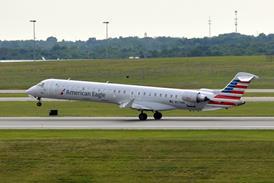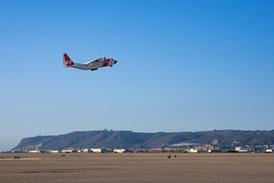As China's aviation brass met in the southern city of Zhuhai early in November for the third China International Aviation and Aerospace Exhibition, the intended message was that the country's industry is maturing.
But Chinese authorities at the same time tacitly admitted great immaturity in the country's passenger air system and gave details of plans to enhance it by establishing a US-style "hub-and-spoke" route network.
Regulatory authorities, in calling on local carriers to increase their fleets of turboprop and regional jet aircraft to support the network, have suggested that without such a system, China's industry will continue to operate inefficiently and will not be able to develop adequately. "Big efforts will be devoted to the development of feeder routes," said CAAC vice-minister Bao Peide during a presentation at the Zhuhai show.
"On the basis of aviation hubs, domestic air routes will be rearranged to establish a new domestic air route network in the first stages, with the rational distribution of aviation hubs, trunk routes and feeder routes. The size of air routes will be compatible with the supplementary co-existence of a hub-and-spoke structure and a city-pairs structure."
Liu Wanming, deputy director-general in the CAAC's department of planning, science and technology, also suggests there is too much reliance on large aircraft for point-to-point services between bigger cities.
He says that in 1999, China had 160 main city-pair air routes, each around 500km (270nm) long and accounting for 17% of the total number of routes in the country, yet "no rational feeder air transport network has taken shape except in Yunnan and Xinjiang".
"Generally speaking, the air transport industry in China is relatively small in scale, and feeder aviation is still at the beginning stages of development," says Liu, adding that just over 60 aircraft seating 70 or fewer passengers are in service.
Market exploitation
Liu further says: "Following the formation of a hub-and-spoke-style air route network, feeder aviation will play an important role in market exploitation, air route network formation, trunk route transportation and flight personnel training. It will be helpful to the growth of airlines and in line with the trend of development of future air transportation."
He adds that over the next five years, the average annual growth rate of passenger traffic on feeder routes is forecast at around 10%, rising to 12% between 2006 and 2015. By 2005, he adds, 10 million passengers a year will be carried on feeder routes, accounting for more than 10% of total passenger traffic.
The CAAC's plans for a hub-and-spoke network are detailed as the Chinese Government has been working in recent years to reorganise the country's aviation bureaucracy and make the local industry profitable overall. Some fear, however, that the market is not ready for operations with smaller aircraft and that it will push China's airlines deeply back into the red.
Until recently, no Chinese carriers operated regional jets on scheduled services. That situation changed in late 1999 when Hainan Airlines ordered 19 Fairchild Dornier 328JETs and took options on 20 more. Hainan has since used these aircraft to launch domestic services between smaller cities and boost frequencies on routes that previously were served infrequently with larger aircraft. It is also considering larger 728JETs and is talking with airport operators about improving infrastructure to better handle quick-turnaround aircraft.
Other growing carriers, including Shandong Airlines and Sichuan Airlines, have followed Hainan by ordering regional jets from Bombardier and Embraer, and optimistic forecasts have been released in the past year about the growth potential of this market segment.
However, some foreign observers have expressed their misgivings on the strategy of heavy RJ use in China at this time. They believe the mass introduction of regional jet aircraft will lead to more pain for airlines, as ticket prices and passenger demand remain too low to justify their use. Accordingly, these observers feel turboprops would be better suited to provide the requisite feeder services.
Outdated technology
However, these observers, who decline to be identified, believe the allure and prestige of operating regional jets has effectively killed any real market that there may have been for turboprops, which many Chinese airlines regard as outdated technology. Some western-made turboprops have been acquired by Chinese airlines in recent years, but they have never caught on strongly.
The fact that former Soviet-era equipment and inefficient Chinese-produced turboprop aircraft were, in the past, foisted onto local carriers may have something to do with this. Just as Tupolevs and Antonovs are now seen in a negative light by Chinese carriers, so too are turboprops.
Doubters still say Chinese carriers will have difficulty moving directly into regional jet operations because of their lack of experience with smaller aircraft. These observers note that the USA and Europe took years to reach the level at which such aircraft could be operated profitably, and to this day turboprops are still in widespread use in those markets.
These same sceptics also fear that a regional jet order boom in China could return the country to the recent difficulties caused by heavy overcapacity. Many airlines, after ordering new Airbus and Boeing aircraft in huge numbers, were caught completely off guard when the Asia-Pacific economic downturn hit in mid-1997. Despite this risk, airlines for the most part have looked only at adding regional jets, hoping that the success of these aircraft in the USA and Europe will be matched in China.
Regional jet manufacturers obviously also disagree with the sceptics and are putting out their own optimistic forecasts for how big the Chinese market will get. Brazilian RJ manufacturer Embraer, for example, predicts that Chinese carriers will order between 400 and 500 regional jets over the next decade.
Fairchild Dornier chairman Chuck Pieper also believes that more than 700 jets and turboprops (in the category below 110-seats) will be required in China and the western Pacific Rim countries over the next 20 years. Of these, he says, more than half will be jets seating between 50 and 100.
Whatever the ultimate size of the market, Pieper says one thing is clear: "The market for the regional jet in China is largely untapped, but the requirement is growing rapidly."
One China-based Western industry observer agrees that the market segment will grow, but he believes the country's carriers will for the most part not be able to make money on regional jets for many years.
"The real reason airlines like Hainan and Shandong have been ordering regional jets is that the CAAC won't allow them to order Airbus and Boeing aircraft," he says. "They want whatever capacity they can get at the moment - even if it means they'll lose money."
Unprofitable competition
If correct, this would appear to be contrary to CAAC policy. One step by China's overhauled regulatory regime over the past few years has been to push airlines to rationalise services and end unprofitable competition on local routes. But there may be some truth in the cynics' statements, because carriers such as Hainan, Shandong and Sichuan admit that gain cannot come without some pain.
Henry Zhang, deputy general manager in the aircraft evaluation office of Hainan's purchasing department, says his carrier recognises that there will be difficulties in the early stages, but that this is a necessary evil in order for development goals to be achieved.
"As a whole we are successful, but in some areas we are not," he says of Hainan's regional jet operations. "This is just the beginning and there is an opportunity. Several airlines are seeking new opportunities to develop the regional market. Now is the time for us."
But Zhang says that apart from the small number of pioneering carriers that have embraced the operation of smaller aircraft, most of the country's 30-odd airlines are not yet willing to do so. "Most of the airlines are reluctant because they are not willing to invest in the market development," he says. "People are eager to make cash and are eager to make a profit, but not to invest. The investment is needed for the market's development."
Zhang claims Hainan's experience with regional jets is that they are "marvellous" for domestic operations, particularly for services in less-developed areas such as the north of the vast country of 1.2 billion people.
He also says local governments have been eagerly supporting the development of feeder services and have committed to improving infrastructure together with willing airlines.
RJs to survive
Some China-watchers say there may be another reason Hainan and a few others have heeded government calls to add regional jets: they are trying to curry favour with state officials in a bid to ensure their survival.
While pressing for the development of feeder services, the CAAC is calling for radical consolidation among the country's 30-plus carriers. It has said that three giant airline groups will be formed, based around Air China, China Eastern Airlines and China Southern Airlines. These carriers are directly administered by the CAAC, as are seven others- China Northern Airlines, China Northwest Airlines, China Southwest Airlines, China Xinjiang Airlines, CNAC-Zhejiang Airlines, Great Wall Airlines and Yunnan Airlines.
When consolidation plans were first announced in mid-2000, they sparked questions about the future of fast-growing "independents" such as Hainan, Shandong and Sichuan. But based on comments by CAAC officials at Zhuhai, it appears they will be allowed to remain commercially independent from regulatory or larger-airline control as they are being praised for leading the way in terms of developing feeder routes in line with government wishes.
The CAAC officials said more pressure would be put on carriers to order regional aircraft during the Tenth Five-year Plan for economic development, which runs from 2001 to 2005.
Since China's economy remains centrally planned, such documents are closely watched for indications of the government's intentions for key industries. Although the plan has not yet been officially tabled, the CAAC's Liu says it will include much in the way of promoting development of feeder services.
He says that to support this development, airport infrastructure will be improved, some tariffs will be cut and financial incentives will be offered to airlines. Domestic carriers will also be encouraged to operate services jointly, while more foreign investment will be sought, both for regional airlines and for airports.
"Feeder aviation in China is in its initial stage of development and the environment and infrastructure for feeder aviation are weak," Liu says. "We should-take measures to promote the development of this field. We should learn the modes and experiences from abroad and we have to pay attention to the specific conditions of our country.
The CAAC says it will also work to support the country's manufacturing industry by encouraging airlines to operate locally made turboprops such as the Xian Aircraft MA-60. A new state-owned leasing company, Shenzhen Financial Leasing, has committed to taking 60 of the type and putting them into service with local carriers.
New Regional Jet
State aerospace company China Aviation Industry Corp I (AVIC I) is, at the same time, pursuing development of its own 50-70-seat regional jet, and Liu says airlines will be encouraged to acquire such a local-build aircraft. Plans for a so-called New Regional Jet were unveiled at the Zhuhai air show, and AVIC I says it hopes foreign investment can be secured and the first aircraft put into service within six years.
Source: Airline Business























